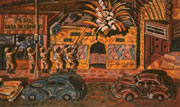
| What is "Time"? | ||||||||||||||||
Time is a concept that we use to structure our understanding of a past, present, and future. The concept of time implies actions or events that have been completed, are in progress, or have yet to occur. Time also implies a sense of self since we must position ourselves relative to these actions/events and, hence, to the past/present/future. |
||||||||||||||||
| What does Time do? | . | |||||||||||||||
Unlike other elements of art which engage viewers by referencing objects or experiences, time engages the viewer by establishing a specific here and now with its own past and future. The establishment of an alternative time frame--as in a work like a film--transports the viewer out of his/her accepted time track, suspending actual reality and temporarily superseding it with the artist's intentions. In a manner of speaking, time in this case becomes timeless: the viewer becomes so involved with the work that he/she loses track of "real" time. The illusion of time or action of time span may be defined in terms of movements:
Examples of time-based work include:
|
||||||||||||||||

